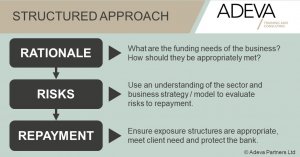This article by one of our partners, Anne-Marie Barcia, was originally published on LinkedIn.
Can problem solving skills be taught?
Recently, an article in the Financial Times caught my attention: “What employers want from MBAs”. Having surveyed 72 employers in 8 countries, the findings are enlightening: The “Ability to solve complex problems” was cited as one of the top 5 most important skills – and one of the top 5 most difficult skills to recruit.
I immediately sent the piece to my 2 sons – useful knowledge when you’re job hunting.
I firmly believe that this is a skill that can be taught – we at Adeva have spent our careers doing so. The question is how?
 At Adeva we build training to equip people with the analytic skills needed to evaluate risk and identify investment opportunities in an increasingly complex and regulated environment. Our success in doing so is built around providing structure to the analytic process alongside the frameworks and tools. The structure provides a practical, work-based, framework that can be instantly transferred to the workplace.
At Adeva we build training to equip people with the analytic skills needed to evaluate risk and identify investment opportunities in an increasingly complex and regulated environment. Our success in doing so is built around providing structure to the analytic process alongside the frameworks and tools. The structure provides a practical, work-based, framework that can be instantly transferred to the workplace.
Increasingly we use a variety of digital learning tools to enable participants to access training as needed, enabling them to learn at their own pace and revisit concepts as needed. Classroom time is spent practicing; applying what they have learned to real scenarios, tackling live challenges, being challenged to support their approach and judgement. But is this enough?
How can learning be embedded? How can we judge its effectiveness?
The question we are asked most often is: How can we embed the learning and ensure that we get a return on the investment? The answer is practice: What you don’t use, you lose. Training is not an event, it is a process. We build skills – both through structured independent learning and in the classroom – and provide job aids and post training activities to further deepen the knowledge and skills, BUT, the role of the organisation, and more specifically the participant’s manager in this process is key. Support needs to be provided to enable participants to practice and apply their new-found skills:
- Before training: Clarity about what success will look like is the starting point for ensuring training’s effectiveness. It begins with the participant and their manager being clear about training goals and time commitments. For example, for a credit analyst, the desired outcome might be that the credit decision is supported with well-chosen quantitative / qualitative evidence, rather than a laundry list of considerations that includes every bit of research uncovered during the analytic process.
- During training: Managers need to be pragmatic about how they support the learning environment, including allocating time for their staff to complete independent learning within work hours and ensuring that classroom time is not interrupted. Management increasingly relies on digital learning as a cost-effective tool for training. This means that individuals can learn at their own pace – which is great, but this could take more, rather than less, time than traditional classroom training.
- After training: For skills to expand and deepen, they need to be supported and honed. Managers play a critical role in this part of the process. Starting with a post training debrief session to discuss and agree how the new skills will be adopted. Regular check-ins and continuous feedback are a must. Get back to basics – review the training goals and time commitments: Do the targets need to be further refined? Managers can provide invaluable and timely guidance to ensure learning is supported and applied. I like the definition of quality as an effort towards constant improvement.
It takes practice, a lot of practice.
